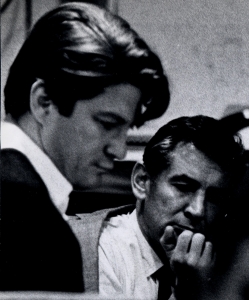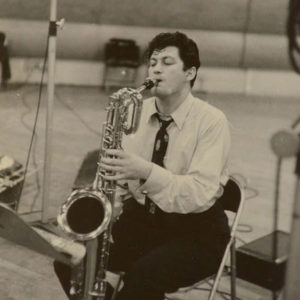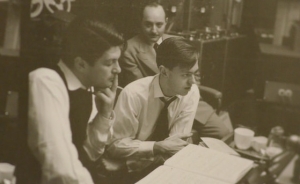David Oppenheim played an instrumental role in Istomin’s career. He was the instigator of the recordings Istomin made for Columbia in the 1950s. He was also a faithful friend, and on occasion, an inspiring chamber music partner.
The multi-faceted career of David Oppenheim – clarinetist, audiovisual producer and teacher
Born in 1922, David Oppenheim had completed his clarinet studies in 1943, but he was immediately mobilized and did not start his career until after the war. He was close to Bernstein, whom he had met in 1942 in Tanglewood, and who dedicated his Sonata for Clarinet and Piano to him. As a freelance musician, he often performed with the New York orchestras, notably under the direction of Bernstein, Toscanini and Stokowski. While continuing to perform as a clarinetist, David Oppenheim joined Columbia in 1950, first as a producer and then as director of ”Artists & Repertoire”. In 1959, he resigned because he was upset by Goddard Lieberson’s policy. His artistic decisions were increasingly dependent on the marketing department, and he was frequently obliged to record the same works over and over again, with the same performers.
In the meantime, he had developed a passion for television and cinema. For about ten years, he worked for CBS TV News and directed several films on music (Casals at 88, Stravinsky). His outstanding career continued as dean of the Department of Arts at New York University (Tisch SoA) from 1969 to 1991, where he contributed to its extraordinary expansion, obtaining funding for a new building and increasing the number of students from six hundred to three thousand.
David Oppenheim continued to play the clarinet until the end of the 1970s, when he became tired of the daily practice. He recorded the Brahms and Mozart Quintets with the Budapest Quartet as well as the Stravinsky Septet. A great admirer of Casals, he came to Prades in 1955 and performed the Brahms complete chamber music for clarinet. He played the Trio Op. 114 with Istomin and Casals, which was recorded by the French Radio and issued on a pirate CD. He retained a vivid memory of the rehearsal, during which Istomin and Casals began bickering over the tempo of the last movement. Istomin wanted it faster, but Casals refused to concede! Oppenheim agreed with Istomin, but was too intimidated to interfere. He had greatly enjoyed this experience – and in retrospect, he felt that Casals was right. He was keen to participate in the first Puerto Rico Festival in 1957 as principal clarinet in the Festival Orchestra, and to perform in the Schubert Octet, but he was deeply disappointed when Casals, due to a serious heart problem, had to renounce playing and conducting.
The Columbia recordings
When David Oppenheim took over the “Artists & Repertoire” responsibility, he strove to establish a coherent recording program, entrusting artists with the works that best suited them and broadening the Columbia catalogue. Regarding the pianists, he decided to keep Casadesus and Serkin, the two prestigious pianists who had been exclusive to Columbia for a long time, but also to appeal to Istomin, who despite his tremendous successes in the concert hall had been somewhat neglected by the former administration. Apart from the chamber music recordings made with Casals in Prades and Perpignan, Columbia had only published two records in ten years: Bach’s Concerto BWV 1052 with Busch (a 1945 78-rpm reissued on LP in 1950) and Brahms’ Handel Variations (a 10 inch LP issued in 1951). Oppenheim convinced Istomin to become fully involved in the preparation of an ambitious recording schedule. Istomin even agreed, contrary to his principles, to record works which he had not performed before in concert. The plans included piano solo works (the complete Nocturnes by Chopin and the Brahms Intermezzi Op. 117 – to be coupled with the Handel Variations on a 12-inch LP, and three sonatas by Beethoven), and five concertos (Rachmaninoff 2, Beethoven 5, Chopin 2, Schumann and Tchaikovsky 1). This challenging program was achieved in less than four years.
Oppenheim’s departure in 1959 brought this adventure to a sudden end. The tapes of the Beethoven sonatas were abandoned until Sony published them in 2015, and all previously scheduled recordings sessions were cancelled. From that time on, Istomin’s recording activity was almost wholly confined to the projects of the Istomin-Stern-Rose Trio. In the 1960s, Istomin was asked to record only two concertos (Brahms 2, Beethoven 4) and a Schubert sonata (D. 850), but the discs were not promoted and were soon removed from the catalogue. It was just a concession to prevent Istomin from leaving Columbia, which would have threatened the continuation of the recordings of the Istomin-Stern-Rose Trio, one of the company’s best-sellers. Thirty years later, David Oppenheim still considered that it had been a huge waste for the company and for Istomin, and that it was yet another manifestation of the incompetence and cynicism which prevailed at Columbia and which had led him to resign.
Interview with Bernard Meillat in New York in 1989
.
Documents
Brahms. Trio for Clarinet, Cello and Piano in A minor Op. 114. David Oppenheim, clarinet. Pablo Casals, cello. Eugene Istomin, piano. Live recording at the Prades Festival on July 3, 1955.
Audio Player.
A recording session with Igor Stravinsky (1955). The major music documentaries that David Oppenheim produced in the 1960s were dedicated to Casals (Casals at 88 in 1964, which was awarded the Prix Italia – we can see a short excerpt on this website) and to Stravinsky (Portrait of Stravinsky in 1965 and 1966). These are fantastic documents! David Oppenheim was a pioneer of the audiovisual and had an eclectic talent. When he was the A&R director at Columbia Records he came up with the idea of making a film about the recording of the Suite from L’Histoire du soldat (The Soldier’s Tale). It is a fascinating document, in which he played a triple role: clarinetist, artistic director of the recording and producer of the film! In addition to David Oppenheim, the musicians for this recording were Alexander Schneider, violin; Julius Levine, double bass; Robert Nagel, trumpet; Loren Glickman, bassoon; Erwin Price, trombone; and Alfred Howard, percussion. Funnily enough, most of them were also regular members of the Pablo Casals Festival Orchestra.




